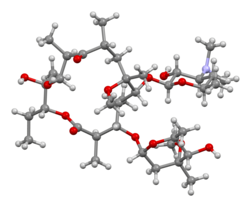
Back كلاريثروميسين Arabic کلاریترومایسین AZB Кларитромицин Bulgarian Claritromicina Catalan Klarithromycin Czech Clarithromycin Welsh Clarithromycin German Κλαριθρομυκίνη Greek Claritromicina Spanish Klaritromizina Basque
 | |
 | |
| Clinical data | |
|---|---|
| Trade names | Biaxin, others |
| Other names | 6-O-Methylerythromycin A |
| AHFS/Drugs.com | Monograph |
| MedlinePlus | a692005 |
| License data | |
| Pregnancy category |
|
| Routes of administration | By mouth, intravenous |
| Drug class | Macrolides |
| ATC code | |
| Legal status | |
| Legal status | |
| Pharmacokinetic data | |
| Bioavailability | 50% |
| Protein binding | Low binding |
| Metabolism | Liver |
| Elimination half-life | 3–4 h |
| Identifiers | |
| |
| CAS Number | |
| PubChem CID | |
| DrugBank | |
| ChemSpider | |
| UNII | |
| KEGG | |
| ChEMBL | |
| CompTox Dashboard (EPA) | |
| ECHA InfoCard | 100.119.644 |
| Chemical and physical data | |
| Formula | C38H69NO13 |
| Molar mass | 747.964 g·mol−1 |
| 3D model (JSmol) | |
| |
| |
| | |
Clarithromycin, sold under the brand name Biaxin among others, is an antibiotic used to treat various bacterial infections.[3] This includes strep throat, pneumonia, skin infections, H. pylori infection, and Lyme disease, among others.[3] Clarithromycin can be taken by mouth as a tablet or liquid or can be infused intravenously.[3]
Common side effects include nausea, vomiting, headaches, and diarrhea.[3] Severe allergic reactions are rare.[3] Liver problems have been reported.[3] It may cause harm if taken during pregnancy.[3] It is in the macrolide class and works by slowing down bacterial protein synthesis.[3] Clarithromycin resistance is already a major challenge to healthcare systems and such resistance is spreading, leading to recommendations to test the susceptibility of pathogenic organisms to the antibiotic before commencing clarithromycin therapy.[4]
Clarithromycin was developed in 1980 and approved for medical use in 1990.[5][6] It is on the World Health Organization's List of Essential Medicines.[7] Clarithromycin is available as a generic medication.[3] It is made from erythromycin and is chemically known as 6-O-methylerythromycin.[8]
- ^ "FDA-sourced list of all drugs with black box warnings (Use Download Full Results and View Query links.)". nctr-crs.fda.gov. FDA. Retrieved 22 October 2023.
- ^ a b c d e f g h i "Clarithromycin". The American Society of Health-System Pharmacists. Archived from the original on 3 September 2015. Retrieved 4 September 2015.
- ^ Mommersteeg MC, Nieuwenburg SA, Wolters LM, Roovers BH, van Vuuren HA, Verhaar AP, et al. (November 2023). "The use of non-invasive stool tests for verification of Helicobacter pylori eradication and clarithromycin resistance". United European Gastroenterol J. 11 (9): e894-903. doi:10.1002/ueg2.12473. PMC 10637120. PMID 37854002.
- ^ Greenwood D (2008). Antimicrobial drugs : chronicle of a twentieth century medical triumph (1 ed.). Oxford: Oxford University Press. p. 239. ISBN 978-0-19-953484-5. Archived from the original on 5 March 2016.
- ^ Fischer J, Ganellin CR (2006). Analogue-based Drug Discovery. John Wiley & Sons. p. 498. ISBN 978-3-527-60749-5.
- ^ World Health Organization (2019). World Health Organization model list of essential medicines: 21st list 2019. Geneva: World Health Organization. hdl:10665/325771. WHO/MVP/EMP/IAU/2019.06. License: CC BY-NC-SA 3.0 IGO.
- ^ Kirst HA (2012). Macrolide Antibiotics (2 ed.). Basel: Birkhäuser Basel. p. 53. ISBN 978-3-0348-8105-0. Archived from the original on 5 March 2016.